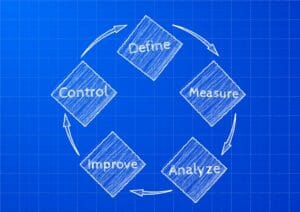Looking to kick off business process improvement (BPI)? The Six Sigma process holds the answer. It’s the analysis of current processes in order to determine which activities can be improved. It aims to discover inefficiencies, delays, bottlenecks, and waste, amongst others, in order to eliminate them through improved processes that are more efficient and deliver greater value to the customer. We discuss everything you need to know, along with the DMAIC methodology and the SIPOC model for Six Sigma.
Six Sigma definition
Six Sigma is a business process improvement methodology designed to improve how you work by decreasing variability and defects. The term Sigma is used to describe the quality of a business process. An organization that is operating at Six Sigma produces 3.4 defects per million opportunities.
Benefits of using Six Sigma
Implementing Six Sigma enables an organization to measure the number of defects in a process and design methods to eliminate them by reducing process variation. Organizations that use this methodology have reduced waste, increased profits, and enhanced shareholder value. The methodology is a widely accepted quality concept worldwide, which promotes the continuous improvement of processes, increases customer satisfaction, helps companies to reduce costs, and improves their productivity and quality of project outputs through a reduction in defects.
The DMAIC methodology for Six Sigma
To implement DMAIC in existing processes, businesses can use a five-step model called DMAIC, which is short for Define, Measure, Analyze, Improve, and Control, as outlined below. DMAIC is built around the basic principle of Y=f(x), where Y represents the output and x represents the inputs. Y represents a dependent variable – and is dependent on x – and represents the symptoms or the effect of a problem.
Define – The problem and the ideal terms of the targets to be achieved are defined.
Measure – Relevant data about the process and the problem is collected using appropriate tools.
Analyze – The process is analyzed to identify the cause-effect relationship between inputs and outputs.
Improve – The solutions for eliminating the root causes are implemented using appropriate tools.
Control – Standards and controls are established to sustain improvements in the long run.
Source: PhotoSpin
SIPOC model for identifying process elements
The SIPOC model is one of the most important tools in the Six Sigma Define phase of the DMAIC methodology. SIPOC is short for Suppliers, Inputs, Processes, Outputs, and Customers. The SIPOC model is used at a high level for representing a process in terms of a series of steps that convert an input into an output. Suppliers provide the inputs, and the customers are the recipients of the outputs. It is useful to have a clear understanding of the purpose and the scope of a process.
Roles and responsibilities in Six Sigma
During a Six Sigma project, members of an organization are assigned specific roles to play. These include:
Executive Management – also referred to as ‘Champions’- consists of a senior-level executive(s) who sponsors a specific Six Sigma project and allows for the commitment of organizational resources towards the project as well as facilitates the resolution of issues.
Business Process Owner – usually a subject matter expert who is knowledgeable in the critical aspects of the business processes in their area of expertise, e.g., engineering, procurement, finance, etc., and cooperates closely with Green Belts and Black Belts (see below) for process improvement initiatives during a project.
Project Manager – responsible for coordinating activities for the project. He/she will be responsible for project deliverables and managing cost, scope, time, risk, human resources, stakeholders, and communications for the project.
Six Sigma Black Belt – is a full-time professional who acts as a team leader, a senior consultant, and an expert on Six Sigma projects. He/she is also responsible for providing guidance and coaching others in the organization about the Six Sigma methodology.
Six Sigma Green Belt – serves as a liaison between the Black Belts and the project team and performs the operations required for the project. They work with the project team to ensure that appropriate deliverables are met.
Team Member – is an individual who has a basic understanding of Six Sigma and who comes to the table with experience or knowledge of a particular project. They are responsible for executing the actual work of the project through guidance provided by Six Sigma green belts and Six Sigma black belts.
Similar Content:
-
How to apply the 7 basic quality tools to the Six Sigma DMAIC methodology
-
Establishing a quality over quantity mindset in our work
-
3 P’s of project management


